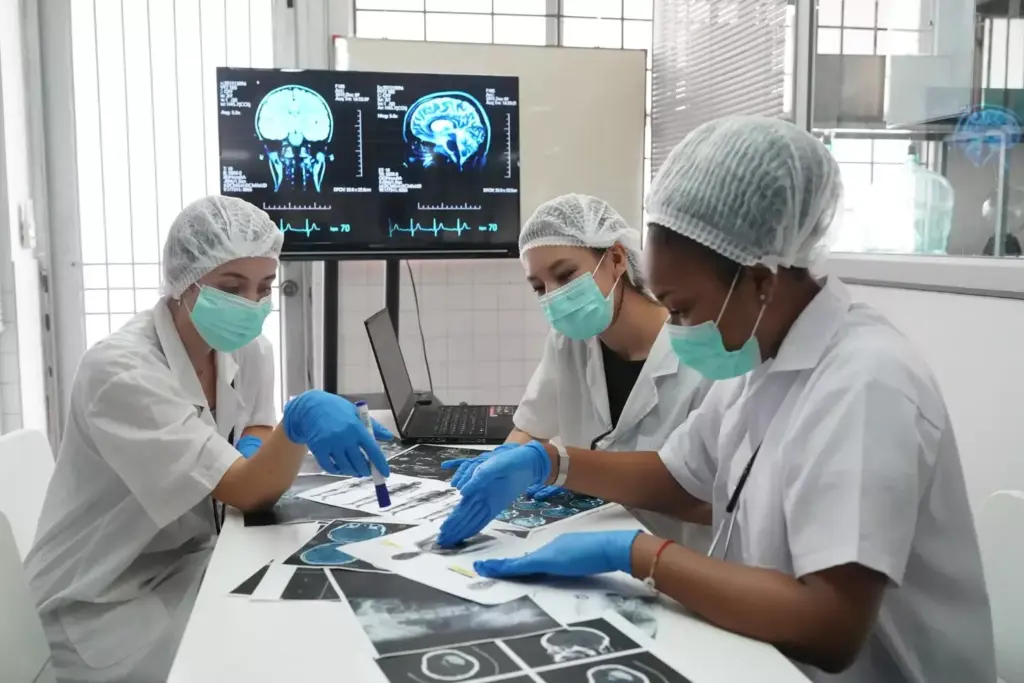Last Updated on November 26, 2025 by Bilal Hasdemir

When you’re diagnosed with a brain tumor, knowing your treatment options is key. We’ll look at the ways to treat brain tumors, focusing on surgery and other methods.
About 70% of primary brain tumors can be removed, based on size, location, and type. Brain tumor removal surgery is a main treatment for many.
We’ll talk about what makes a tumor operable and the surgical methods used. This includes brain cancer surgery and brain tumor resection. Our aim is to give you a full picture of your treatment choices.
Key Takeaways
- Nearly 70% of primary brain tumors are operable.
- Brain tumor removal surgery is a primary treatment option.
- The operability of a brain tumor depends on its size, location, and type.
- Surgical techniques include brain cancer surgery and brain tumor resection.
- Understanding the available treatment options is key for patients.
Understanding Brain Tumors and Their Classification
Brain tumors are abnormal growths in the brain. They can be benign or malignant. Knowing their classification is key to finding the right treatment. We will look at the different types, symptoms, and how they are diagnosed.
Types of Brain Tumors: Malignant vs. Non-Malignant
Brain tumors fall into two main categories: malignant and non-malignant. Malignant brain tumors are cancerous and can spread to other brain tissue. Non-malignant (benign) tumors grow slower and don’t spread. Knowing the type of tumor is vital for treatment.
The grade of a tumor also matters. The World Health Organization (WHO) grading system rates tumors from I (least malignant) to IV (most malignant). This helps doctors choose the best treatment.
| Tumor Type | Characteristics | WHO Grade |
|---|---|---|
| Malignant | Cancerous, invasive | III-IV |
| Non-Malignant | Benign, slow-growing | I-II |
Common Brain Tumor Symptoms and Diagnosis
Symptoms of brain tumors vary based on their location, size, and type. Common signs include headaches, seizures, and changes in thinking. Doctors use MRI and CT scans, along with biopsies, to diagnose.
Some tumors may not show symptoms until they grow large. Regular check-ups are important for early detection. For more on silent brain tumors, visit this resource.
The Impact of Brain Tumors on Quality of Life
Brain tumors can greatly affect a person’s life. They can impact thinking, physical abilities, and mood. The tumor’s location, size, and treatment plan are key factors.
Good treatment and support can help improve life quality. We focus on a care plan that meets physical, emotional, and social needs.
Evaluating Brain Tumor Operability Factors
When it comes to removing brain tumors, knowing what makes them operable is key. The choice to have surgery depends on the tumor’s details and the patient’s health.
The 70% Rule: When Tumors Are Considered Operable
About 70% of primary brain tumors can be removed surgically. The 70% rule is a basic guide. But, the actual number can change based on the tumor’s size, location, and type.
Critical Factors: Location, Size, and Tumor Type
Several key factors decide if a brain tumor can be removed. These are:
- Location: Tumors in easy-to-reach brain areas are more likely to be operable.
- Size: Bigger tumors are harder to remove fully. Smaller ones might be easier to take out.
- Tumor Type: Whether the tumor is malignant or benign affects if it can be removed. For more on brain tumor types, check out the National Institute of Neurological Disorders and.
Patient-Specific Considerations for Surgery Eligibility
Each patient’s situation is unique when it comes to surgery. Important factors include:
- Overall Health: Patients in better health are usually better candidates for surgery.
- Medical History: Past health issues or surgeries can influence the decision to operate.
- Age and Performance Status: Younger patients or those with a good performance status often do better.
Neurosurgeons carefully look at these factors to decide the best treatment for brain tumors. They weigh the surgery’s benefits against its risks.
Brain Tumor Medical Procedures: A Detailed Approach
Diagnosing and treating brain tumors requires advanced medical procedures. These steps are key to figuring out the tumor’s type and how serious it is. They help doctors plan the best treatment.
Diagnostic Imaging and Biopsy Techniques
Diagnostic imaging is very important for finding brain tumors. MRI (Magnetic Resonance Imaging) and CT (Computed Tomography) scans give clear pictures of the brain. They help doctors see where the tumor is, how big it is, and what it looks like.
A leading neurosurgeon said,
“The accuracy of diagnostic imaging is key for planning surgery and treatment.”
Biopsy techniques are also vital. They involve taking tissue samples for lab tests. This is done through stereotactic biopsy or open biopsy during surgery.
Multidisciplinary Treatment Planning
Planning treatment for brain tumors needs a team effort. Neurosurgeons, neuro-oncologists, and radiation oncologists work together. They create a treatment plan that fits the tumor’s type, grade, and location, and the patient’s health.
- Looking at the tumor’s characteristics
- Checking the patient’s health and what they prefer
- Thinking about surgery and other options
Risk Assessment and Surgical Decision-Making
Assessing risks is a big part of deciding if surgery is right for brain tumors. Surgeons weigh the risks of surgery, like possible brain damage, against the benefits of removing the tumor.
The choice to have surgery depends on the tumor’s location, size, and the patient’s health.
Traditional Surgical Techniques for Brain Tumor Removal
The way we treat brain tumors has changed a lot. We use old methods that are very effective. These methods help us give the best care to our patients.
Craniotomy: The Gold Standard Procedure
Craniotomy is a key surgery for removing brain tumors. It means taking part of the skull off to get to the tumor. This lets surgeons see and take out the tumor, helping many patients.
The steps in a craniotomy are:
- Preoperative planning with advanced imaging
- Removing a bone flap to get to the brain
- Removing the tumor under a microscope or endoscope
- Putting the bone flap back
Craniotomy’s benefits include direct access to the tumor. This makes removing it more precise and safer for the brain around it.
Awake Brain Surgery: Preserving Critical Functions
Awake brain surgery is a complex method. It’s used for tumors near important brain areas. The patient stays awake during parts of the surgery to keep important functions safe.
The awake brain surgery process is:
- Starting with anesthesia to get the patient ready
- Waking the patient during key parts of the surgery
- Watching how the patient responds to keep functions safe
- Finishing the surgery under general anesthesia if needed
Awake brain surgery is great for tumors near areas that control speech, movement, or other important functions.
Surgical Approaches for Different Brain Regions
Each brain area needs its own surgical plan. The choice depends on the tumor’s location, size, and type.
Some common methods include:
- Frontal craniotomy for tumors in the frontal lobe
- Temporal craniotomy for tumors in the temporal lobe
- Suboccipital craniotomy for tumors in the posterior fossa
Choosing the right surgical approach helps neurosurgeons remove tumors successfully. It also lowers the risks.
Advanced Surgical Approaches for Brain Mass Surgery
Advanced surgical methods have changed how we treat brain masses. These new techniques make surgery more precise and reduce recovery time. They also improve patient outcomes. Thanks to these advancements, we can now treat brain masses more effectively than before.
Stereotactic Radiosurgery: Precision Without Incisions
Stereotactic radiosurgery (SRS) is a precise radiation therapy. It focuses a high dose on the tumor while protecting healthy tissue. This method is great for tumors that are hard to reach or in sensitive brain areas. It’s a non-invasive option that reduces risks and speeds up recovery.
Advanced imaging and computer technology make SRS very precise. It can target tumors accurately. This technique works well for many types of brain masses, both malignant and non-malignant.
Laser Ablation Techniques for Deep-Seated Tumors
Laser ablation uses heat to kill tumor cells. It’s good for deep tumors that are hard to reach with traditional surgery. MRI guidance helps surgeons target the tumor without harming nearby brain tissue.
Laser ablation has many benefits. It lowers the risk of infection and post-operative pain. It also means shorter hospital stays. This method is less invasive than traditional surgery, making it a good choice for tumors in hard-to-reach areas.
Minimally Invasive Endoscopic Approaches
Minimally invasive endoscopic surgery uses a small camera and tools to remove tumors through small cuts. This method causes less damage to the brain and surrounding tissues. It results in less pain and faster recovery.
Endoscopic surgery is great for tumors near the brain’s surface or in accessible areas like the nasal cavity. It uses smaller incisions, reducing complications and promoting quicker healing.
Technological Innovations Revolutionizing Brain Tumor Surgery
The field of brain tumor surgery is changing fast, thanks to new technologies. These advancements make surgeries more precise and help patients recover faster.
Neuronavigation and 3D Mapping Systems
Neuronavigation systems are key in today’s brain tumor surgeries. They use advanced imaging to create 3D brain maps. This helps surgeons find tumors accurately and avoid important brain areas.
3D mapping systems also let surgeons see tumors and brain structures clearly. This clear view helps plan and perform surgeries better, leading to better results for patients.
Fluorescence-Guided Surgery for Enhanced Visualization
Fluorescence-guided surgery is changing brain tumor surgery too. It uses fluorescent dyes to highlight tumors, making them stand out. This makes it easier to remove tumors while keeping healthy tissue safe.
This method is great for tumors near important brain areas. It helps surgeons work in these tricky spots with more confidence and precision.
Ultrasound Aspiration and Intraoperative Imaging
Ultrasound aspiration is a new way to remove tumors. It uses sound waves to break up and take out tumor tissue. It’s good for tumors that are hard to reach or in sensitive brain areas.
Intraoperative imaging, like MRI and CT scans, lets surgeons check how much tumor is removed during surgery. This feedback helps make sure the tumor is removed completely, often avoiding the need for more surgeries.
These new technologies are making brain tumor surgery better. They help make surgeries more precise, safe, and effective. As these technologies get even better, we can expect even better results for patients.
When Tumors Are Classified as Inoperable Brain Masses
Inoperable brain masses are a big challenge in neuro-oncology. Knowing a brain tumor is inoperable changes treatment options and care for patients.
Defining “Inoperable”: Beyond Surgical Reach
A brain tumor is inoperable if surgery is too risky. Inoperable brain masses can be dangerous if surgery is tried.
Reasons a tumor might be inoperable include:
- It’s in a critical or sensitive brain area.
- It’s close to important blood vessels or neural paths.
- The tumor is too big or has spread too far.
- The patient’s health makes surgery too risky.
Options for Partial Removal and Debulking
Even if full removal isn’t possible, partial removal or debulking can help. It can ease symptoms and improve life quality. This method can also reduce pressure on the brain.
| Treatment Approach | Description | Benefits |
|---|---|---|
| Partial Removal | Surgical removal of a part of the tumor | Reduces tumor size, eases symptoms |
| Debulking | Reduces the tumor’s volume | Lessens pressure on the brain |
Quality of Life Considerations for Inoperable Tumors
For those with inoperable brain tumors, keeping quality of life high is key. We focus on managing symptoms, controlling pain, and providing supportive care.
Quality of life matters include:
- Managing symptoms like seizures, headaches, and cognitive changes.
- Offering emotional and psychological support.
- Coordinating care from different specialists for full support.
We understand the complexity of treating inoperable brain masses. We’re dedicated to giving our patients compassionate, complete care.
Non-Surgical Treatment Alternatives for Brain Cancer
When surgery isn’t an option, non-surgical treatments are key for brain cancer care. These options can be used alone or with surgery for full treatment.
Radiation Therapy: External Beam and Brachytherapy
Radiation therapy is a mainstay for non-surgical brain cancer treatment. External beam radiation therapy sends beams from outside the body to hit tumor cells. This method targets the tumor well while protecting healthy tissue.
Brachytherapy places radioactive material close to or in the tumor. It’s great for some brain tumors.
Radiation therapy can shrink tumors, slow their growth, or ease symptoms. It’s used when surgery isn’t possible due to tumor location or patient health.
Systemic Treatments: Chemotherapy and Targeted Therapies
Systemic treatments are vital for non-surgical brain cancer care. Chemotherapy uses drugs to kill cancer cells everywhere in the body. Though it can have side effects, it’s a key treatment for many.
Targeted therapies are more precise, focusing on cancer growth molecules. They’re often more effective and have fewer side effects than traditional chemotherapy.
Emerging Options: Immunotherapy and Gene Therapy
The field of brain cancer treatment is growing fast, with immunotherapy and gene therapy leading the way. Immunotherapy uses the body’s immune system to fight cancer. Gene therapy tries to fix or change genes to prevent or treat cancer.
These new treatments offer hope for brain cancer patients, even those with tumors resistant to traditional treatments. Research and trials are ongoing, helping us learn more about these options.
Recovery and Outcomes After Brain Tumor Treatment
It’s important for patients and their families to understand the recovery process after brain tumor treatment. The journey to get better involves many stages and things to consider.
Post-Surgical Recovery Timeline and Expectations
After surgery, patients usually stay in the hospital for a few days. The time they stay can change based on their health and the surgery’s complexity. We know that post-surgical recovery is a key time that needs careful attention.
Right after surgery, patients might feel tired, have headaches, or notice other neurological symptoms. These symptoms are usually short-term and get better as the brain heals. Our team gives each patient personalized care to help manage these symptoms.
Rehabilitation Strategies for Neurological Function
Rehabilitation is key to help patients regain strength and neurological function after treatment. Our strategies include physical, occupational, and speech therapy, all tailored to each patient’s needs.
- Physical therapy helps improve mobility and balance.
- Occupational therapy assists patients in regaining daily living skills.
- Speech therapy addresses any communication or swallowing difficulties.
Survival Statistics and Prognostic Factors
It’s important for patients to know about survival statistics and what can affect their outcome. Survival rates change a lot based on the tumor type, grade, and the patient’s health.
| Tumor Type | 5-Year Survival Rate | Prognostic Factors |
|---|---|---|
| Glioblastoma | 5-10% | Age, performance status, extent of resection |
| Meningioma | 70-90% | Tumor grade, extent of resection, patient age |
We want to remind everyone that each patient’s journey is different. These statistics are just a general guide and shouldn’t predict what will happen to an individual. Our team is dedicated to giving the best care and support during treatment and recovery.
Conclusion: Advances and Hope in Brain Tumor Treatment
There have been big steps forward in treating brain tumors, giving hope to those with brain cancer. New surgical methods, like craniotomy and awake brain surgery, help remove tumors more accurately. Also, new tech like neuronavigation and fluorescence-guided surgery make surgery safer and more precise.
New treatments like radiation therapy and targeted therapies offer more options for patients. These options help those with tumors that can’t be removed or need extra care after surgery. These advances have made treatments better and improved life quality for brain tumor patients.
We keep working to improve medical knowledge and technology. Our team is committed to giving top-notch care to international patients. We aim to stay ahead in brain tumor treatment, ensuring patients get the best care. With ongoing research, we’re hopeful about the future of treating brain tumors and the hope it brings to patients and their families.
FAQ
What are the primary treatment options for brain tumors?
Treatments for brain tumors include surgery, radiation, and chemotherapy. We also look at new options like immunotherapy and gene therapy.
Can all brain tumors be removed surgically?
No, not all brain tumors can be removed by surgery. Whether surgery is possible depends on the tumor’s location, size, and type, and the patient’s health.
What is the 70% rule in determining brain tumor operability?
The 70% rule helps decide if surgery is an option. It means if more than 70% of the tumor can be safely removed, surgery might be considered.
What are the benefits of minimally invasive brain tumor surgery?
Minimally invasive surgery, like endoscopic approaches, has many benefits. It reduces risks, causes less damage, and leads to faster recovery compared to traditional surgery.
How do technological innovations improve brain tumor surgery?
New technologies like neuronavigation and fluorescence-guided surgery enhance brain tumor surgery. They improve precision, visualization, and safety, leading to better results.
What are the non-surgical treatment alternatives for brain cancer?
Non-surgical treatments for brain cancer include radiation, chemotherapy, and targeted therapies. New options like immunotherapy and gene therapy are also available, used alone or with surgery.
What is the recovery process like after brain tumor surgery?
Recovery after brain tumor surgery varies. It includes rest, rehabilitation, and follow-up care. This helps manage any neurological deficits.
How do brain tumors affect quality of life, and what can be done to improve it?
Brain tumors can greatly affect quality of life, causing symptoms like cognitive issues and emotional changes. Effective treatment, rehabilitation, and supportive care can improve life quality.
What are the survival statistics for brain tumor patients, and what factors influence prognosis?
Survival rates for brain tumor patients vary. Factors like tumor type, grade, and location, along with patient health, play a big role. The extent of surgery and response to treatments also affect outcomes.
Are there any new or experimental treatments for brain tumors?
Yes, research is ongoing for new treatments. This includes advanced surgical techniques, new radiation therapies, and innovative systemic treatments like immunotherapy and gene therapy.








